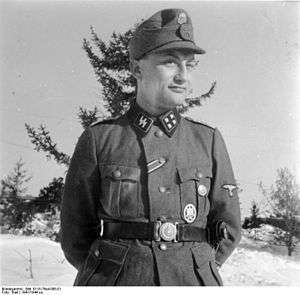SS-Standarte Kurt Eggers

The SS-Standarte Kurt Eggers was a German Waffen SS propaganda formation which publicised the actions of all Waffen SS combat formations, seeing action in all major theatres of war with the exception of North Africa. The "Berichter" (literally: reporters) of the Standarte were expected to fight actively, if the situation demanded it. They were fully trained and well-equipped.
Formation
- SS-Kriegsberichter-Kompanie
- SS-Kriegsberichter-Abteilung
- SS-Standarte Kurt Eggers
Unit history
The SS-Kriegsberichter-Kompanie (SS War Reporter Company) originated in January 1940 with an original formation of four platoons of war correspondents and their support staff. The platoons were able to operate independently of each other, each equipped with still and movie cameras to enable to units to visually document the actions of Waffen-SS men in combat.
The company came under the command of ex-Allgemeine SS Standartenführer Günter d'Alquen. Upon his transfer to the Waffen-SS, d'Alquen was given the rank of Waffen-SS Hauptsturmführer der Reserve. d'Alquen would command the unit throughout its existence, ending the war as an Waffen-SS Standartenführer der Reserve.
Soon after its formation, one platoon was attached to each of the four Waffen-SS combat formations. These platoons would remain attached to their respective formations throughout the campaigns in France and the Low Countries, reporting on the actions of the SS combat formations during the campaign.
The platoons remained attached to the SS combat units during the campaigns in the Balkans, taking many famous photographs, including that of SS-Standartenführer Kurt Meyer at the battle for the Kleisoura Pass.
By August 1941, the number of Waffen-SS formations had increased, and so the SS-Kriegsberichter-Kompanie increased in size as well, becoming the SS-Kriegsberichter-Abteilung. As an Abteilung, the unit had several more war-correspondent units attached to it, enabling it to cover the actions of all the Waffen-SS formations in the field.
As the number of SS combat-formations increased, so did the number of correspondents required. In December 1943, the unit reached regimental size and received the name SS-Standarte Kurt Eggers. The honorary title Kurt Eggers referred to the SS war-correspondent and editor of the SS magazine Das Schwarze Korps who had been killed earlier in the year, while reporting on the Wiking's battles near Kharkov.
Many foreign volunteers became Kurt Eggers photographers, movie cameramen, writers, broadcasters and recorders, and most were multilingual. Several formations within the Standarte were formed to gather information for occupied or allied countries, and these sub-units were generally staffed by volunteers of the relevant nationality. At least two U.S. citizens, several British and a New Zealander served with the Standarte in the course of World War II. "Three English volunteers are known to have served in this unit, Railton Freeman (aka Royston and Metcalfe), who was sentenced to ten years’ imprisonment after the War,[1][2] Dennis John Leister (aka Beckwith)[3] and Francis Paul Maton (aka Wood) as well as one from New Zealand: Roy Nicholias Courlander (aka Regan)."
Order of Battle: SS-Standarte Kurt Eggers, January 1944
- Stab der Standarte
- Abteilung Verwaltung
- Unterkunftsverwaltung
- Gruppe Wort
- Verbindungsführer Presse
- Gruppe Bild
- Referat Bildtechnik
- Referat Bildschriftleitung
- Referat Bildarchiv
- Gruppe Rundfunk
- Referat Rundfunkstechnik
- Referat Rundfunksendung
- Abschnitt Russland-Nord
- Abschnitt Russland-Süd
- Abschnitt Lettland und Lettische Einheiten
- Abschnitt Südost
- Abschnitt West
- Sonderunternehmen Südost
- Kommando Oslo
- Kommando Kopenhagen
- Kommando Frankreich
- Kommando Brüssel
- Kommando Südost
- Kommando Adria
- Ersatz-Kompanie
- Ausbildungsgruppe
- Gruppe Kampfpropaganda
- 2 x SS-Kampfpropaganda Zug
- Sonderunternehmen "Südstern"
- "Skorpion Ost"
- "Skorpion West" (Ober-Rhein)
- Unternehmen "Wintermärchen"
See also
- Gunter d'Alquen
- Martin James Monti
- Waffen-SS
- List of German military units of World War II
- Waffen-SS foreign volunteers and conscripts
Footnotes
- ↑ Weale, Adrian (2014-11-12). Renegades (Kindle Locations 3363-3364). Random House. Kindle Edition
- ↑ and in respect of whom a British Security Service file is held by The National Archives under reference KV2/631
- ↑ Weale, Adrian (2014-11-12). Renegades (Kindle Location 2991). Random House. Kindle Edition